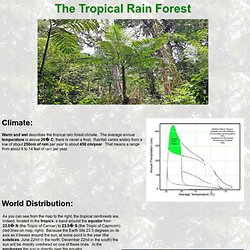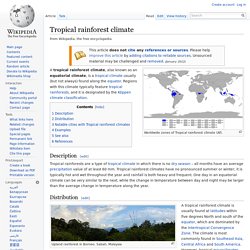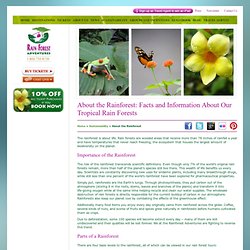

Climate. Tropical Rain Forest. As you can see from the map to the right, the tropical rainforests are, indeed, located in the tropics, a band around the equator from 23.5 N (the Tropic of Cancer) to 23.5 S (the Tropic of Capricorn) (red lines on map, right).

Because the Earth tilts 23.5 degrees on its axis as it travels around the sun, at some point in the year (the solstices, June 22nd in the north, December 22nd in the south) the sun will be directly overhead on one of these lines. At the equinoxes the sun is directly over the equator. Within this band, solar radiation is most intense, and thus the surface of the planet warms the most.
The warmth leads to a lot of evaporation, and as warm, moist air rises, it cools, the water condenses, and the water falls back to the earth as rain. Thus, the warmest areas of the planet also tend to be the wettest, and this sets the stage for the tropical rain forest. Not all of the land in the tropics is tropical rainforest. Tropical rainforest climate. Worldwide zones of Tropical rainforest climate (Af).

A tropical rainforest climate, also known as an equatorial climate, is a tropical climate usually (but not always) found along the equator. Regions with this climate typically feature tropical rainforests, and it is designated by the Köppen climate classification. Description[edit] Distribution[edit] Upland rainforest in Borneo. A tropical rainforest climate is usually found at latitudes within five degrees North and south of the equator, which are dominated by the Intertropical Convergence Zone. Some of the places that have this climate are indeed uniformly and monotonously wet throughout the year (e.g., the northwest Pacific coast of South and Central America, from Ecuador to Costa Rica, see for instance, Andagoya, Colombia), but in many cases the period of higher sun and longer days is distinctly driest (as at Palembang, Indonesia) or the time of lower sun and shorter days may have more rain (as at Sitiawan, Malaysia).
Examples[edit] Rainforest Climate. Rainforest Climate. Rain 3.
Plants. Rainforest Plants. Rainforest Plants. Rainforest Plants. Rainforest Plants. Rainforest Plants. Animals. Animals. Rainforest Animals. Rainforest Animals. Rainforest Animals. Rainforest Animals. Rainforest Animals. Interesting facts. Facts on the Rainforest. Top 10 facts about the Amazon Rainforest.
The Amazon is synonymous with Central and South America – it’s the largest of the rainforests, supporting a huge number of plants and animals and hugely important to our own survival.

Taking up most of the Amazon Basin, the Amazon rainforest is mostly contained within Brazil, and stretches into Peru, Ecuador, Bolivia, and smaller parts in some other South American countries. Here are ten interesting facts about the Amazon (and rainforests in general) that you may not have heard before. 1. Around 80% of the food we eat originally came from rainforests. Some of the more popular examples include coffee, chocolate, rice, tomatoes, potatoes, bananas, black pepper, pineapples and corn. 2. 3. Tropical Rainforest Biome Facts. Fun Rainforest Facts for Kids - Interesting Facts about Tropical & Temperate Rainforests. About the Rainforest - Information and Facts on Tropical Rainforests, Save the Rain Forest. The role of the rainforest transcends scientific definitions.

Even though only 7% of the world’s original rain forests remain, more than half of the planet’s species still live there. This wealth of life benefits us every day. Scientists are constantly discovering new uses for endemic plants, including many breakthrough drugs, while still less than one percent of the world’s rainforest have been explored for pharmaceutical properties. Simply put, rainforests are the Earth’s lungs. Through photosynthesis, they pull carbon out of the atmosphere (storing it in the roots, stems, leaves and branches of the plants) and transform it into life-giving oxygen while at the same time helping recycle and clean our water supplies.
Additionally many food items you enjoy every day originally came from rainforest across the globe. Due to deforestation, some 100 species will become extinct every day – many of them are still undiscovered and their qualities will be lost forever.